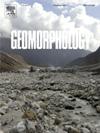没有植被的河流不再存在:美国西南部莫哈韦河和阿玛戈萨河的植物-景观相互作用
IF 3.1
2区 地球科学
Q2 GEOGRAPHY, PHYSICAL
引用次数: 0
摘要
植被是河流过程的关键影响因素,但当它是众多潜在控制因素之一时,分离其影响是具有挑战性的。因此,在地貌学和沉积学上,人们对了解无植被的河流很感兴趣,这使得人们可以在不受植物生物地貌控制的情况下研究河流系统。以前的研究通过两种方式评估无植被河流:1)通过解释古沉积岩记录中的冲积特征,这些特征早于陆地植物的进化;2)通过对河段尺度上植物覆盖有限或不存在的“无植被”现代河流的地貌观测。美国大盆地的阿玛戈萨河和莫哈韦河的集水区曾报道过典型的“无植被”河段。然而,本研究表明,这些河段不能被认为是真正的无植被,通过原始地貌观测和已发表的历史数据的结合应用,揭示了植被在多个时间和长度尺度上的基本影响。本研究对洪水发生前后被描述为“无植被”地区的原位植物、木材物质和生物地貌结构进行了编目,发现有机质堵塞和生物地貌结构的丰度与其他旱地系统的记录相当。此外,一些生物地貌结构通过影响洪泛区强度和沉积等参数来影响河面尺度形态。这些观测结果补充了上游生物地貌结构的观测结果,以说明植被在控制下游泥沙输送中的作用。将这些观测结果与最近和较长时间遗传植被影响的证据相结合,我们得出结论,这两条河都不能充分反映无植被的条件,不应该这样考虑。这一结论可以推广到其他所谓的现代“无植被”河流,这些河流可能受到植被的生物地貌影响:1)河段尺度,2)上游汇水区输入,3)作为景观记忆继承。本文章由计算机程序翻译,如有差异,请以英文原文为准。
Unvegetated rivers no longer exist: Plant-landscape interactions in the Mojave and Amargosa rivers, SW USA
Vegetation is a key influence on fluvial processes, but isolating its impacts is challenging when it is one amongst many potential controls. Accordingly, there is geomorphological and sedimentological interest in understanding unvegetated rivers, which allow for the investigation of fluvial systems in isolation from the biogeomorphic controls imposed by plants. Previous studies have assessed unvegetated rivers in two ways: 1) by interpreting alluvial signatures in the ancient sedimentary rock record that pre-date the evolution of land plants; and 2) through geomorphic observations of “unvegetated” modern rivers, where plant coverage is limited or absent at the reach scale. Archetypal “unvegetated” reaches have previously been reported from the catchments of the Amargosa and Mojave rivers in the Great Basin, USA. However, the present study demonstrates that such reaches cannot be considered truly unvegetated, through the combined application of original geomorphic observations and published historical data that reveal a fundamental influence of vegetation at multiple time and length scales. This study catalogs in situ plants, wood matter, and biogeomorphic structures in reaches previously described as “unvegetated”, both before and after flood events, and finds that the abundance of organic matter jams and biogeomorphic structures are comparable to those recorded in other dryland systems. Further, some of the biogeomorphic structures are shown to influence reach-scale morphology by affecting parameters such as floodplain strength and aggradation. These observations are supplemented with those of upstream biogeomorphic structures to account for the role of vegetation in controlling downstream sediment transmission. Combining these observations with evidence of inherited vegetation influences from the recent and deep time, we conclude that neither river adequately reflects unvegetated conditions and should not be considered as such. This conclusion can be generalized to other purported modern “unvegetated” rivers, which are likely subject to the biogeomorphic influences of vegetation 1) at the reach scale, 2) imported from upstream catchment areas, and 3) inherited as landscape memory.
求助全文
通过发布文献求助,成功后即可免费获取论文全文。
去求助
来源期刊

Geomorphology
地学-地球科学综合
CiteScore
8.00
自引率
10.30%
发文量
309
审稿时长
3.4 months
期刊介绍:
Our journal''s scope includes geomorphic themes of: tectonics and regional structure; glacial processes and landforms; fluvial sequences, Quaternary environmental change and dating; fluvial processes and landforms; mass movement, slopes and periglacial processes; hillslopes and soil erosion; weathering, karst and soils; aeolian processes and landforms, coastal dunes and arid environments; coastal and marine processes, estuaries and lakes; modelling, theoretical and quantitative geomorphology; DEM, GIS and remote sensing methods and applications; hazards, applied and planetary geomorphology; and volcanics.
 求助内容:
求助内容: 应助结果提醒方式:
应助结果提醒方式:


